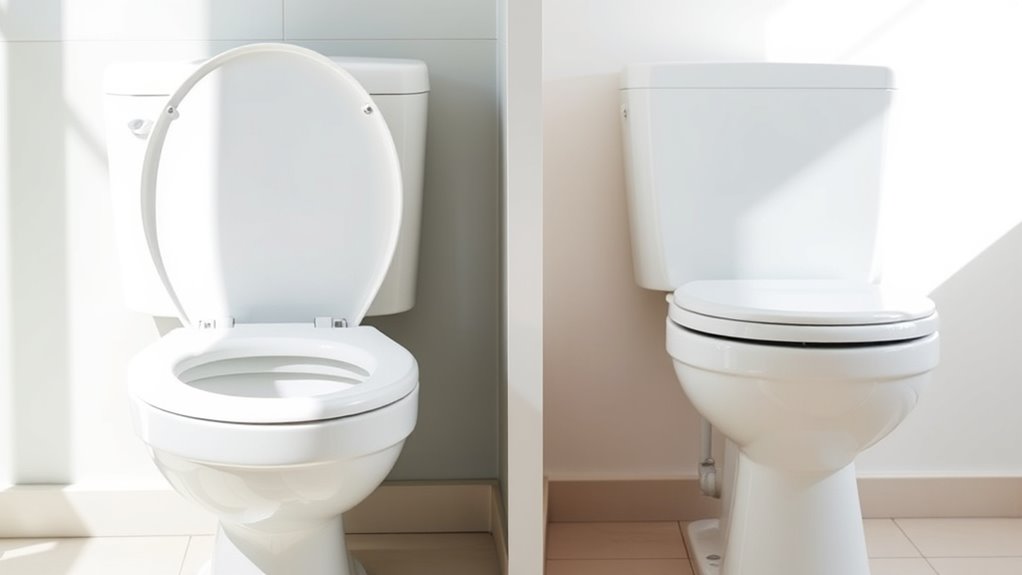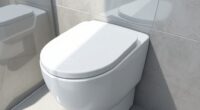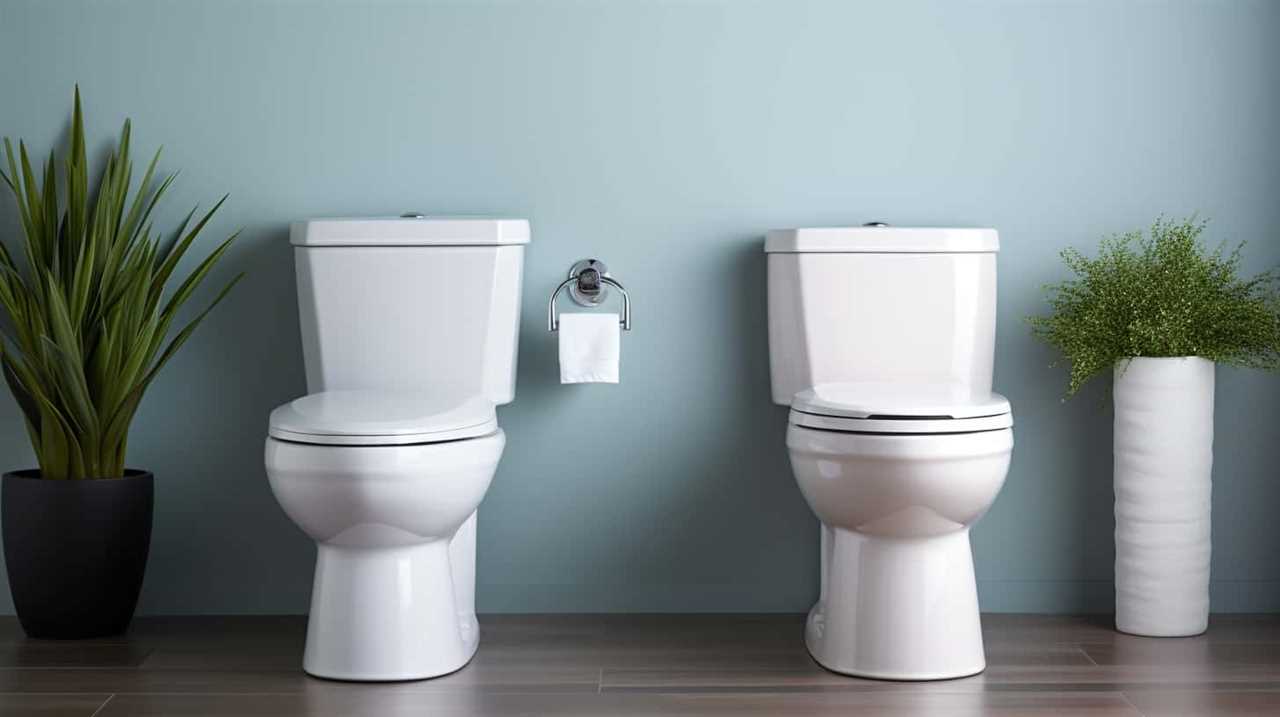If you’re comparing gravity-feed and pressure-assisted toilets, you’ll find that pressure-assisted models deliver a stronger, more effective flush, often using less water and reducing the need for multiple tries. However, they tend to be noisier and might not suit quiet environments. Gravity models are quieter, simpler to maintain, and more budget-friendly, making them ideal for many households. To discover which option fits your needs best, explore the differences further below.
Key Takeaways
- Pressure-assisted toilets provide stronger, more effective flushes, especially suitable for heavy usage or larger households.
- Gravity-feed models typically operate more quietly, making them better for noise-sensitive environments.
- Pressure-assisted toilets often use less water per flush, improving water efficiency and reducing utility bills.
- Gravity toilets are generally simpler, easier to maintain, and more cost-effective than pressure-assisted models.
- Advances in technology are making pressure-assisted toilets quieter, narrowing the noise difference between the two types.

When choosing between gravity-feed and pressure-assisted toilets, understanding how each system works can help you make an informed decision. Both types serve the same fundamental purpose but differ considerably in performance, efficiency, and user experience. Gravity-feed toilets rely on the force of gravity to flush waste, using a tank filled with water that drops down into the bowl when you push the handle. This simple mechanism makes them cost-effective and easier to maintain. Pressure-assisted toilets, on the other hand, use compressed air in a sealed tank to force water into the bowl with greater force, resulting in a more powerful flush. This increased force means waste is cleared more effectively, especially if you have a larger household or need a toilet that handles heavy use.
When it comes to water efficiency, pressure-assisted toilets tend to use less water per flush compared to gravity-feed models. Because they deliver a more forceful and complete flush, they often require fewer flushes to clear the bowl, reducing overall water consumption. This can translate into notable savings on your water bill, especially if you’re mindful of water conservation. However, some gravity-feed toilets are designed with dual-flush technology, enabling you to choose a partial flush for liquid waste, which can further enhance water efficiency. So, if conserving water is one of your priorities, a pressure-assisted model might be the better choice, but look for models with water-saving features if you prefer gravity-feed.
Noise levels are another critical factor to consider. Gravity-feed toilets are generally quieter because their flushing mechanism is straightforward and doesn’t involve compressed air or additional moving parts. When you flush a gravity toilet, you’ll hear a typical water drop and a gentle whooshing sound. Pressure-assisted toilets, however, tend to be noisier due to the compressed air mechanism activating during the flush. The sound can be quite loud—similar to a small explosion—making them less suitable for homes where noise sensitivity is a concern, especially in shared bathrooms or in households with early risers or night-shift workers. If you value a quieter bathroom experience, a gravity-feed toilet might be more appropriate. Additionally, advancements in technology are leading to quieter pressure-assisted models that reduce noise levels.
Frequently Asked Questions
Which Toilet Type Is More Environmentally Friendly?
You’ll find that gravity-feed toilets are generally more eco-friendly because they use less water per flush, supporting water conservation efforts. They often come with eco-friendly features like dual-flush options, which help you save even more. Pressure-assisted toilets tend to use more water and energy to operate, making them less ideal for eco-conscious choices. So, if you want a greener option, go with a gravity-feed toilet with water-saving features.
How Do Noise Levels Compare During Flushing?
You might think pressure-assisted toilets are noisier, but that’s not always true. Flushing noise and operational sounds can vary, and some pressure-assisted models are surprisingly quiet due to modern technology. Gravity-feed toilets often produce softer, more consistent flushing sounds, while pressure-assisted ones can generate sharper noises during operation. Ultimately, noise levels depend on the specific model, so it’s worth testing different options to find the quietest fit for your needs.
Are Pressure-Assisted Toilets More Expensive to Repair?
Yes, pressure-assisted toilets tend to be more expensive to repair. Their repair costs are higher because they involve specialized parts and more complex mechanisms, which can lead to increased maintenance challenges. You might find that fixing issues with pressure-assisted models requires professional help more often, adding to your overall expenses. Keep in mind that these toilets may save water and reduce clogs, but their repair costs are definitely higher.
Do Both Types Require the Same Water Pressure?
Coincidentally, your water pressure requirements differ between these toilet types. Pressure-assisted toilets need higher water pressure for ideal performance, making installation more complex due to specific requirements. Gravity-feed toilets work well with standard water pressure, so they’re generally easier and cheaper to install and maintain. If your home has low water pressure, a gravity-feed model might be better. Understanding these installation differences helps you choose the right toilet for your needs.
Which Toilet Is Easier for Seniors to Use?
You’ll find gravity-feed toilets easier for seniors to use, thanks to their typically higher seat height, which improves elderly accessibility. They require less effort to flush and are simpler to operate, making them more user-friendly. Pressure-assisted toilets can be louder and may have a steeper learning curve. So, for ease of use, especially for seniors, a gravity-feed toilet generally offers a better experience.
Conclusion
Choosing between gravity-feed and pressure-assisted toilets is like picking between a gentle stream and a rushing river—each has its own power. I once watched a pressure-assisted toilet flush with such force, it reminded me of a firehose clearing debris effortlessly. If you value a strong, reliable flush that saves water and minimizes clogs, pressure-assisted toilets might be your best bet. Ultimately, understanding your needs helps you make the right choice for a cleaner, more efficient bathroom experience.










